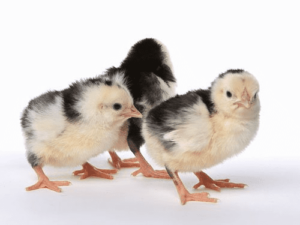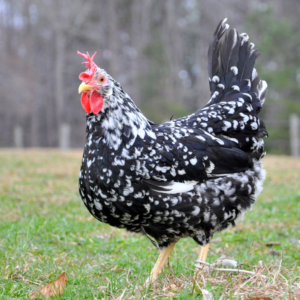Discovering the Delights of The Ancona Chicken Breed
Ancona chickens stand out as versatile, spirited, and utterly captivating. From their rich history to their unique characteristics, there’s much to learn and love about these charming birds. The story of Ancona chickens traces back to the picturesque province of Ancona, Italy, where these birds first gained prominence in the early 19th century. Bred from Leghorn stock, Ancona chickens quickly garnered attention for their striking mottled plumage and robust constitution. Over time, they found their way to farms and homesteads around the world, leaving a lasting legacy in the annals of poultry history.
Egg-cellent Eggs: Size, Color, and Production
Size
Ancona chicken eggs come in various sizes, typically ranging from medium to large.
Color
Their shells display a captivating array of colors, from creamy white to light brown, adding a touch of elegance to any egg basket.
Production per year
Ancona hens are prolific layers, capable of producing around 200 to 250 eggs per year. Their consistent egg-laying prowess makes them a valuable addition to any flock or farm.
When do Ancona chickens start laying eggs?
Ancona chickens typically begin laying eggs at around 5 to 6 months of age, although individual variations may occur. As they mature, they embark on their egg-laying journey, contributing to the farm’s bounty with each clutch.
Ancona Chicken Characteristics
Temperament and pet potential: The friendly Ancona chicken
Ancona chickens are renowned for their spirited demeanor and amiable disposition, making them wonderful companions for both novice and experienced poultry keepers. They thrive on human interaction and are known to develop strong bonds with their caregivers. With proper handling and care, Ancona chickens can indeed make delightful pets, adding joy and personality to any backyard or farm setting.
How do I tame Ancona chickens?
Taming Ancona chickens is a rewarding endeavor that requires patience, consistency, and gentle handling. Start by spending time with your chickens daily, offering treats and speaking to them in soothing tones. Gradually introduce hand-feeding and gentle touches, allowing the chickens to acclimate to your presence and develop trust over time.
Ideal Ancona chicken flock size
When it comes to flock size, Ancona chickens thrive in the company of their peers. A flock of 4 to 6 chickens is considered ideal, providing ample social interaction while minimizing overcrowding. Additionally, Ancona chickens generally get along well with other breeds, thanks to their friendly nature and adaptable temperament.
How much space do they need?
Ancona chickens are active foragers that appreciate space to explore and roam. A minimum of 4 square feet of coop space per bird is recommended, with additional space for outdoor ranging. Access to fresh air, sunlight, and ample room to stretch their wings is essential for their physical and mental well-being.
Will they mix with my other chickens?
Ancona chickens are generally sociable birds that coexist peacefully with other chicken breeds. When introducing new chickens to the flock, monitor their interactions closely and provide ample space and resources to prevent aggression or territorial behavior. With proper introductions and supervision, Ancona chickens can form harmonious relationships with their feathered counterparts.
Appearance: The striking beauty of Ancona chickens
Ancona chickens are adorned with a distinctive mottled plumage pattern, characterized by black or blue feathers splashed with white markings. Their medium-sized bodies are well-proportioned, with bright red combs and wattles adding a pop of color to their appearance. Overall, Ancona chickens exude elegance and charm, making them a visual delight in any poultry flock.
Nutritional Needs: Feeding Your Ancona Flock
Feeding Ancona Chicks: Birth to 8 Weeks
- Starter Feed: From hatching to around 8 weeks of age, Ancona chicks require a specialized starter feed formulated specifically for young chicks. This feed is rich in essential nutrients such as protein, vitamins, and minerals, which are vital for healthy growth and development.
- Protein Content: Choose a starter feed with a protein content of around 18% to 20%, as this supports proper muscle and tissue development in growing chicks.
- Feeding Frequency: Offer starter feed to Ancona chicks ad libitum, meaning it should be available to them at all times. Chicks have small stomachs and high metabolic rates, so frequent access to feed is essential for optimal growth.
- Supplemental Heat: Provide a consistent heat source, such as a heat lamp or brooder, to maintain the chicks’ body temperature during the early weeks of life. This encourages healthy digestion and prevents chilling.
- Fresh Water: Alongside starter feed, ensure that fresh, clean water is readily available to Ancona chicks at all times. Use shallow waterers to prevent accidental drowning and regularly change the water to maintain cleanliness.
Transitioning to Grower Feed: 8 Weeks to Point of Lay
- Grower Feed Introduction: Around 8 weeks of age, gradually transition Ancona chicks from starter feed to grower feed. Grower feed contains slightly lower levels of protein compared to starter feed but still provides the essential nutrients needed for growth and development.
- Protein Content: Choose a grower feed with a protein content of around 16% to 18%, as this meets the nutritional requirements of growing chickens without promoting excessive weight gain.
- Feeding Schedule: Offer grower feed to Ancona chickens in measured quantities, providing enough feed to satisfy their hunger without overfeeding. Monitor their appetite and adjust the feeding amounts as needed to prevent wastage and ensure steady growth.
- Healthy Treats: Introduce small amounts of healthy treats such as finely chopped greens, fruits, or mealworms to Ancona chickens as occasional supplements to their diet. These treats provide enrichment and variety while offering additional nutrients.
Preparing for Egg Production: Point of Lay Onward
- Layer Feed Transition: As Ancona chickens approach the point of lay, typically around 18 to 20 weeks of age, transition them to a specialized layer feed designed specifically for laying hens. Layer feed contains higher levels of calcium and other nutrients essential for eggshell formation and overall reproductive health.
- Calcium Supplementation: Alongside layer feed, provide free-choice calcium supplements such as crushed oyster shells or limestone grit. Calcium supplementation is crucial for Ancona hens to produce strong, healthy eggshells.
- Feeding Routine: Continue to offer layer feed and supplemental calcium to Ancona hens on a regular schedule, ensuring access to fresh water at all times. Monitor their egg production and adjust feed quantities as needed to support optimal laying performance.
By providing a balanced and nutritious diet tailored to each stage of development, you can support the healthy growth, development, and eventual egg-laying success of your Ancona chickens. Consistent access to high-quality feed, fresh water, and appropriate supplements is key to ensuring their well-being and productivity throughout their lives.
Strengths and Weaknesses: Evaluating the Ancona Chicken
Ancona chickens boast numerous strengths, including their excellent egg-laying abilities, friendly demeanor, and adaptability to various climates. They thrive in free-range environments and are adept at foraging for food. However, like any breed, they have their weaknesses, such as their susceptibility to certain poultry diseases and their tendency to be flighty if not handled regularly.
Embracing the Enchantment of Ancona Chickens
In conclusion, Ancona chickens are a breed apart, cherished for their beauty, personality, and practical utility. Whether you’re a seasoned poultry keeper or a backyard enthusiast, these remarkable birds have much to offer in terms of companionship, egg production, and sheer enjoyment. By understanding their history, care requirements, and unique attributes, you can embark on a rewarding journey with Ancona chickens by your side.


